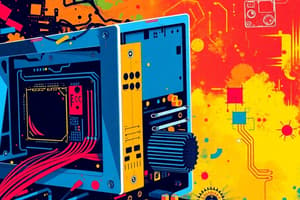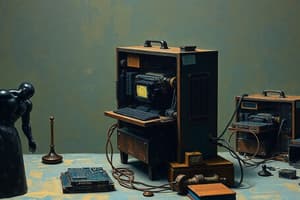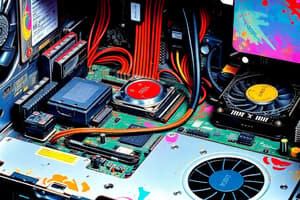Podcast
Questions and Answers
What should you check to determine how to connect a keyboard?
What should you check to determine how to connect a keyboard?
- The type of operating system installed
- Whether it has a USB or PS/2 connector (correct)
- The length of the keyboard cable
- The power status of the computer
What should be avoided when installing a keyboard?
What should be avoided when installing a keyboard?
- Pegging the keyboard to the computer case
- Connecting it while the computer is powered on (correct)
- Using a USB port for connection
- Reading the instruction manual
What is a common connection type used for monitors?
What is a common connection type used for monitors?
- RS232
- Ethernet
- USB-C
- DVI, VGA, or HDMI (correct)
What is the first step in installing a printer?
What is the first step in installing a printer?
What do you need to do after connecting the speakers to the computer?
What do you need to do after connecting the speakers to the computer?
Which action should be taken when installing a webcam?
Which action should be taken when installing a webcam?
What is a necessary step when installing a monitor to utilize maximum resolution?
What is a necessary step when installing a monitor to utilize maximum resolution?
What is the role of the Printer Install Wizard during printer installation?
What is the role of the Printer Install Wizard during printer installation?
What is the main reason disassembly is emphasized before assembly in computer servicing?
What is the main reason disassembly is emphasized before assembly in computer servicing?
Which of the following is NOT a recommended preparation step for disassembly?
Which of the following is NOT a recommended preparation step for disassembly?
What should be checked before disassembling a computer according to the performance checklist?
What should be checked before disassembling a computer according to the performance checklist?
What is a crucial action to take regarding the CPU during assembly?
What is a crucial action to take regarding the CPU during assembly?
Which component should be removed first during the disassembly process?
Which component should be removed first during the disassembly process?
Why is it important to document the specifications of components before reassembly?
Why is it important to document the specifications of components before reassembly?
What should be done to the equipment and parts before starting the assembly process?
What should be done to the equipment and parts before starting the assembly process?
Which of the following items is directly involved in the assembly phase according to the performance checklist?
Which of the following items is directly involved in the assembly phase according to the performance checklist?
Flashcards
Why start with disassembly?
Why start with disassembly?
Learning disassembly first helps you understand how to reassemble a computer. In real-world settings, technicians often work on repairs, which involves taking apart devices.
Essential for safety?
Essential for safety?
Anti-static wrist strap and mat are crucial to protect sensitive electronics from static electricity, which can damage components.
Before disassembling?
Before disassembling?
Prior to taking apart a computer, ensure the system unit is unplugged to prevent electrical shocks and damage.
Performance Checklist: Disassembly
Performance Checklist: Disassembly
Signup and view all the flashcards
Documenting Specs
Documenting Specs
Signup and view all the flashcards
Cleaning Before Assembly
Cleaning Before Assembly
Signup and view all the flashcards
Thermal Paste
Thermal Paste
Signup and view all the flashcards
Performance Checklist: Assembly
Performance Checklist: Assembly
Signup and view all the flashcards
I/O Devices Installation Order
I/O Devices Installation Order
Signup and view all the flashcards
Keyboard Installation (General Steps)
Keyboard Installation (General Steps)
Signup and view all the flashcards
Mouse Installation (General Steps)
Mouse Installation (General Steps)
Signup and view all the flashcards
Monitor Installation (General Steps)
Monitor Installation (General Steps)
Signup and view all the flashcards
Speaker Installation (General Steps)
Speaker Installation (General Steps)
Signup and view all the flashcards
Webcam Installation (General Steps)
Webcam Installation (General Steps)
Signup and view all the flashcards
Printer Installation (General Steps)
Printer Installation (General Steps)
Signup and view all the flashcards
Study Notes
Computer Disassembly and Assembly
- Disassembly is prioritized over assembly to understand component placement and reassembly. Industrial servicing involves frequent disassembly.
Disassembly Preparation
- Crucial Steps: Unplug the system unit, wear an anti-static wrist strap, use an anti-static mat, and use a large, long table.
Disassembly Performance Checklist
- Safety First: Ensure the system unit is unplugged before beginning disassembly.
- Protective Gear: Properly wear anti-static wrist straps and other personal protective equipment (PPE).
- Component Removal: Safely and correctly remove the outer casing, case fan, CPU fan, power supply, RAM, optical disk drive, hard drive, and motherboard.
Assembly Preparation
- Pre-Assembly Steps: Thoroughly clean equipment and parts. Avoid leaving the CPU exposed. Prepare thermal paste reapplication. Wear an anti-static wrist strap.
Assembly Performance Checklist
- Hygiene is Key: Clean the equipment and parts before commencing assembly.
- Protective Gear is Essential: Wear anti-static wrist straps, and other PPE.
- Component Installation: Correctly and carefully install CPU Fan, Hard Drive, Optical Drive, RAM, Power Supply, Interface Cards (graphics/video cards), and system fan. Secure the system cover.
Installing I/O Devices
- Essential Peripherals: Focus on installing keyboard, mouse, monitor, speakers, webcam, and printer. These devices control the computer.
Keyboard Installation
- Connector Identification: Locate USB or PS/2 connector.
- Secure Connection: Connect keyboard to its respective port. Avoid power on/off while keyboard is connected.
Mouse Installation
- Similar Procedure: Similar to keyboard installation, identify connector type (USB or PS/2).
Monitor Installation
- Connection Type: Use DVI, VGA, or HDMI for optimal picture quality. Connect to the video card or motherboard port. Drivers may be needed for maximum resolution.
Speaker Installation
- Connector Identification: Determine speaker connector type and connect cable to the computer's line-out jack.
- Power Connection: Plug in power cord.
Webcam Installation
- Simple Connection: Usually a USB plug-in. Drivers may be required, check manufacturer's manual.
Printer Installation
- Prerequisites: Ensure printer and power cable are accessible.
- Connection: Connect printer connector to the computer.
- Cartridge Insertion: Insert appropriate ink/toner cartridge.
- Power On: Turn on printer and computer.
- Install Driver: Use the Printer Install Wizard to install the printer driver.
- Test Print: Run a test print to confirm correct installation.
Studying That Suits You
Use AI to generate personalized quizzes and flashcards to suit your learning preferences.




